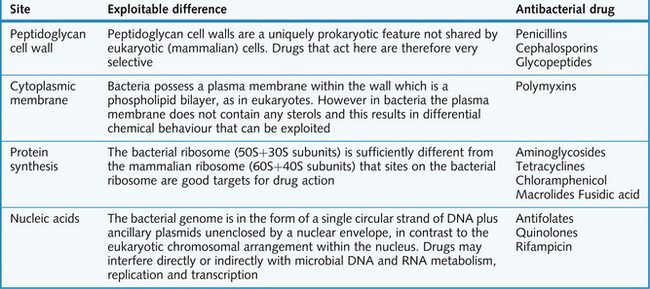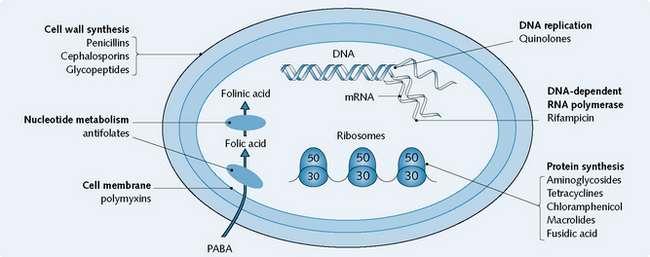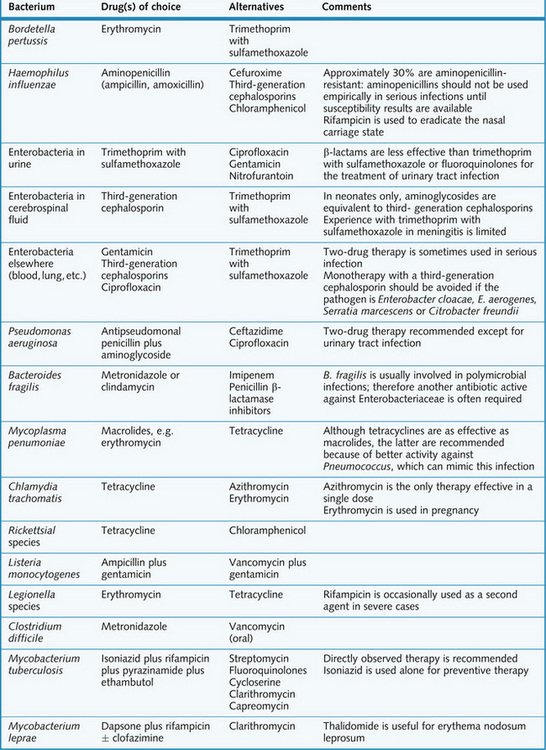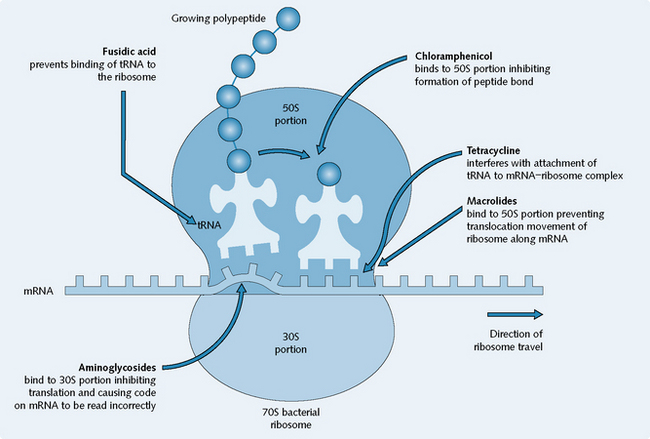11 Infectious diseases
Antibacterial drugs
Concepts of antibacterial chemotherapy
The principal treatment of infections is with antibiotics. These antibacterial agents can be:
Classification of antibiotics
There are three main ways of classifying antibiotics:
In this chapter, antibiotics have been described according to their site of action.
Antibacterial drugs that inhibit cell wall synthesis
Penicillins
Mechanism of action
Penicillins bind to penicillin-binding proteins on susceptible microorganisms. This interaction results in inhibition of peptide cross-linking within the microbial cell wall, and indirect activation of autolytic enzymes. The combined result is lysis (see Fig. 11.2).
Spectrum of activity
Penicillins exhibit considerable diversity in their spectrum of activity (Fig. 11.3).
Cephalosporins
The cephalosporins comprise a large group of drugs. The three main subgroups include:
Glycopeptides
Vancomycin and teicoplanin are the classical glycopeptides.
Mechanism of action
Glycopeptides are bactericidal. They inhibit peptidoglycan synthesis, with possible effects on RNA synthesis (see Fig. 11.2).
Spectrum of activity
Vancomycin is active only against aerobic and anaerobic Gram-positive bacteria. Glycopeptides are reserved for resistant staphylococcal infections and Clostridium difficile in antibiotic-associated pseudomembranous colitis (see Fig. 11.3).
Antibacterial drugs that inhibit bacterial nucleic acids
Antibacterial drugs that inhibit bacterial nucleic acids include (Fig. 11.2):
Mechanism of action
Folate is an essential co-factor in the synthesis of purines and hence of DNA. Bacteria, unlike mammals, must synthesize their own folate from para-aminobenzoic acid (Fig. 11.2). This pathway can be inhibited at two points: the sulphonamides inhibit dihydrofolate synthetase, and are bacteriostatic while trimethoprim inhibits dihydrofolate reductase and are bacteriostatic.
Spectrum of activity
The sulphonamides are used for ‘simple’ urinary tract infections (UTIs). Trimethoprim and co-trimoxazole (trimethoprim and sulfamethoxazole) are used for UTIs and respiratory tract infections (see Fig. 11.3).
Quinolones
Ciprofloxacin and nalidixic acid are quinolones.
Mechanism of action
Quinolones are bactericidal. They act by inhibiting prokaryotic DNA gyrase. This enzyme packages DNA into supercoils and is essential for DNA replication and repair (see Fig. 11.2).
Spectrum of activity
Ciprofloxacin has a broad spectrum of activity, while nalidixic acid is more narrowly active against Gram-negative organisms (see Fig. 11.3).
Contraindications
Quinolones should not be given with theophylline as theophylline toxicity may be precipitated.
Antibacterial drugs that inhibit protein synthesis
Antibacterial drugs that inhibit protein synthesis include:
The site of action of these drugs is summarized in Figure 11.4.
Aminoglycosides
Examples of aminoglycosides include gentamicin, streptomycin, netilmicin and amikacin.
Mechanism of action
Aminoglycosides are bactericidal. They bind irreversibly to the 30S portion of the bacterial ribosome. This inhibits the translation of mRNA to protein and causes more frequent misreading of the prokaryotic genetic code (see Fig. 11.4).
Spectrum of activity
Aminoglycosides have a broad spectrum of activity but with low activity against anaerobes, streptococci and pneumococci (see Fig. 11.3). Streptomycin is used against Mycobacterium tuberculosis (p. 174).
Tetracyclines
Examples of tetracyclines include tetracycline, minocycline, doxycycline.
Mechanism of action
Tetracyclines are bacteriostatic. They work by selective uptake into bacterial cells due to active bacterial transport systems not possessed by mammalian cells. The tetracycline then binds reversibly to the 30S subunit of the bacterial ribosome, interfering with the attachment of tRNA to the mRNA ribosome complex (see Fig. 11.4).
Spectrum of activity
Tetracyclines have broad-spectrum activity against Gram-positive and Gram-negative bacteria, as well as intracellular pathogens (see Fig. 11.3).
Chloramphenicol
Mechanism of action
Chloramphenicol is both bactericidal and bacteriostatic, depending on the bacterial species. It reversibly binds to the 50S subunit of the bacterial ribosome, inhibiting the formation of peptide bonds (see Fig. 11.4).
Spectrum of activity
Chloramphenicol has a broad spectrum of activity against many Gram-positive cocci and Gram-negative organisms (see Fig. 11.3). Because of its toxicity, it is reserved for life-threatening infections, especially typhoid fever and meningitis.
Macrolides
Erythromycin, clarithromycin and azithromycin are examples of macrolides.
Fusidic acid
Miscellaneous antibacterials
Other antibacterial drugs include:
Metronidazole and tinidazole
Nitrofurantoin
Bacitracin
Polymyxins
Colistin is an example of a polymyxin, though this class is seldom prescribed due to its toxicity
Mechanism of action
Polymyxins are bactericidal. They are peptides that interact with phospholipids on the outer plasma cell membranes of Gram-negative bacteria, disrupting their structure. This disruption destroys the bacteria’s osmotic barrier, leading to lysis (Fig. 11.2).
Spectrum of activity
Polymyxins are active only against Gram-negative bacteria including Pseudomonas aeruginosa (see Fig. 11.3).
Antimycobacterial drugs
Antituberculosis therapy
The first-line drugs used in the treatment of tuberculosis are:
Stay updated, free articles. Join our Telegram channel

Full access? Get Clinical Tree







